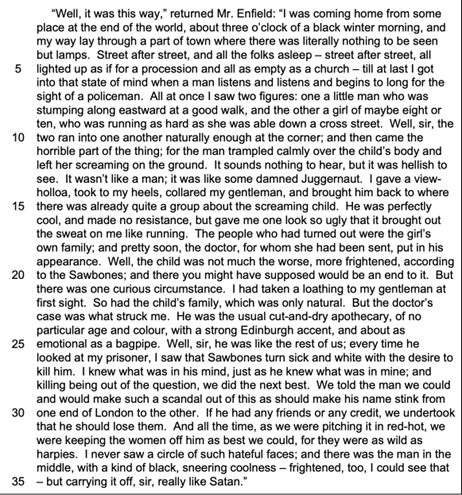Explore how far Stevenson presents Mr Hyde as a threatening and dangerous character


Stevenson presents Mr Hyde as a deeply threatening and dangerous character in Strange Case of Dr Jekyll and Mr Hyde, using unsettling descriptions, the reactions of others, and broader themes to reinforce Hyde’s embodiment of evil. Through him, Stevenson explores the consequences of unchecked desires and the darker aspects of human nature, challenging Victorian moral and social conventions. This extract highlights Hyde’s menace, which Stevenson continues to develop throughout the novel.
In this extract, Hyde’s actions are immediately horrifying. Stevenson’s use of violent imagery (“trampled calmly”) creates an unsettling juxtaposition; the adverb “calmly” contrasts with the brutality, suggesting a lack of remorse and reinforcing Hyde’s inhumanity. Hyde mercilessly tramples over a young girl in the street, leaving her “screaming” and “lying on the ground,” which shocks the onlookers. This act introduces Hyde as a figure of mindless cruelty, establishing his menace from the outset. ……
Video Breakdown preview
This video provides a detailed walkthrough of a Level 6 model answer to the 2019 AQA English Literature question on The Strange Case of Dr Jekyll and Mr Hyde. The question explores how far Stevenson presents Mr Hyde as a threatening and dangerous character, both in the extract and across the novel. The breakdown dissects high-level analytical techniques used in a top-mark essay and compares them to Level 4 responses to highlight what elevates analysis to Level 6.
Key areas covered include:
-
-
A strong, conceptual thesis that frames Hyde as the embodiment of repressed desires and the darker side of human nature.
-
Close AO2 analysis of Stevenson’s methods, including violent imagery (“trampled calmly”), religious allusions (“juggernaut”), and animalistic metaphors (“ape-like fury”) to emphasise Hyde’s menace.
-
Exploration of Hyde’s symbolic role in Victorian society, reflecting anxieties around duality, repression, and respectability.
-
Evaluation of key scenes such as the trampling of the girl, the murder of Sir Danvers Carew, Dr Lanyon’s trauma, and Hyde’s dominance over Jekyll, showing how his threat is both physical and existential.
-
Integration of AO3 context, linking Hyde’s character to Victorian fears of degeneration, moral decay, and scientific overreach.
-
A conceptual conclusion that reframes Hyde as a challenge to Victorian social order, representing mankind’s darkest impulses.
-
 Alex Sharp is a seasoned English specialist with over a decade of experience teaching and examining GCSE English Literature and Language. As an AQA examiner, Alex has marked thousands of scripts, gaining deep insight into what examiners look for and...
Alex Sharp is a seasoned English specialist with over a decade of experience teaching and examining GCSE English Literature and Language. As an AQA examiner, Alex has marked thousands of scripts, gaining deep insight into what examiners look for and...